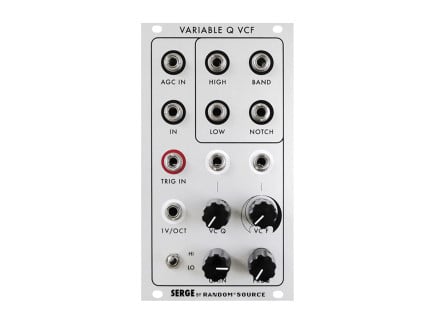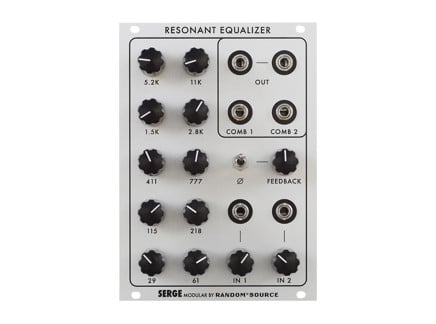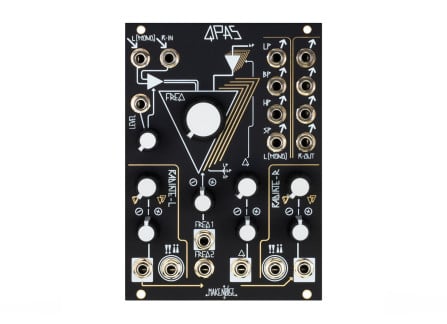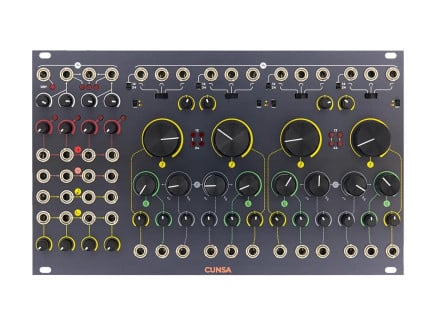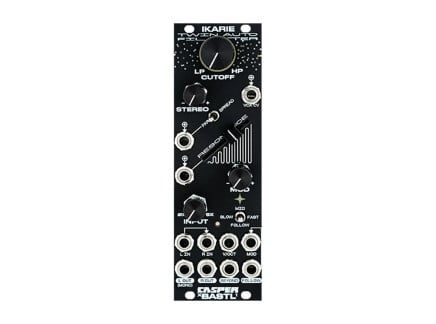Filters are most commonly known and used as a way to shape the harmonic content of an audio signal, often from an oscillator. They are pivotal to so-called East Coast synthesis and subtractive synthesis, where the start of many patches is taking a harmonically rich waveform, such as square or sawtooth, and running it into a filter, most commonly a low pass filter.
However, there are ways to create sound using a filter, either by self-oscillation or by filter pinging. In this article, we’ll go over filter pinging and some of the modules especially well suited for it.
What is Filter Pinging?
Imagine striking an object, such as a glass, with your finger. You get a sharp onset, a ringing, and finally, the sound decays away to nothing. The frequency of the resulting sound is determined by the size and shape of the object you hit. The resonant structure of the object determines how short or long the resulting sound lasts. A glass will ring longer than a piece of wood. A small champagne glass will sound higher in pitch than a large glass bowl.
Now, we can take this analogy to the realm of synthesis and filter pinging. Pinging relies on feedback in order to make it work, in this case, filter resonance. Resonance, or Q as it’s sometimes called, is an emphasis at the cutoff frequency of a filter created by feeding the output back into the input of the filter, creating a feedback loop. Some filters—but not all—will oscillate if the resonance is turned up enough, making it possible to use them as a sound source all on their own.
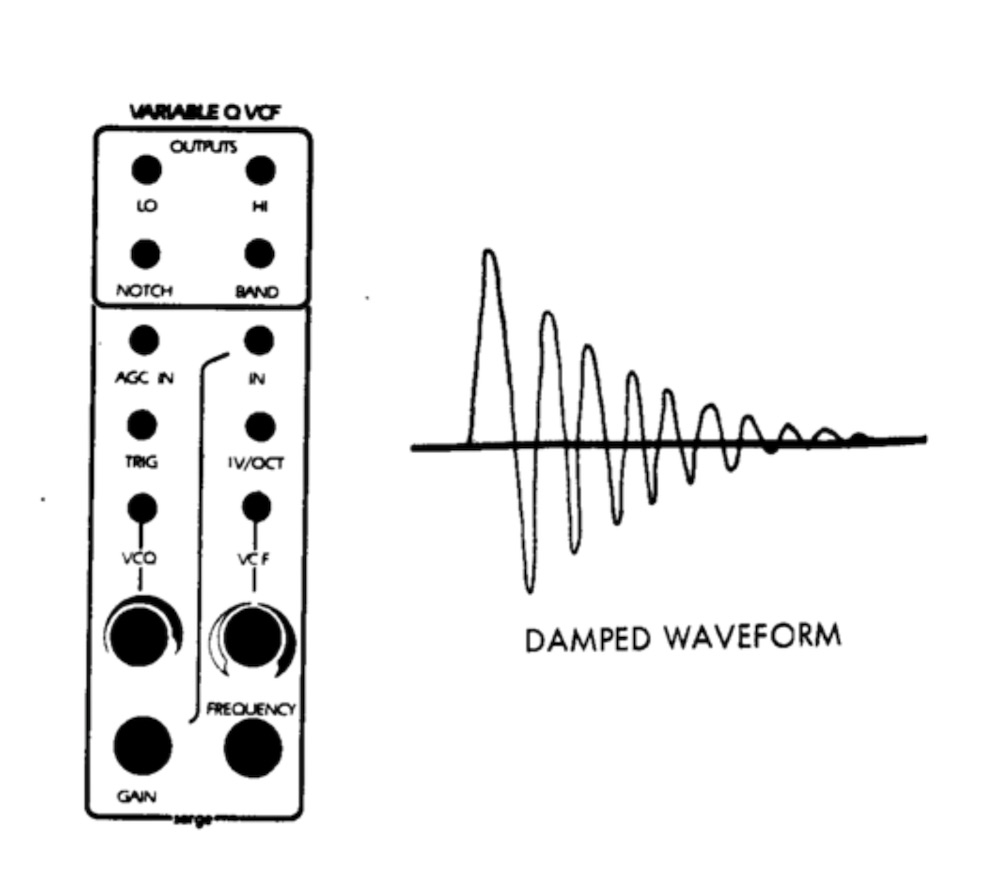
[Above: a filter pinging diagram from a late 1970s brochure for Serge Modular Music Systems, detailing potential uses of their Variable Q Filter (VCFQ).]
For filter pinging, you don’t want the filter to self-oscillate, as it will create a droning sine wave. For pinging or self-oscillation, the filter's cutoff frequency determines the pitch of the resulting sound. The resonance should sit right on the edge of self-oscillation—but not quite creating a sound on its own. Send a trigger signal or short envelope into the audio input of the filter. Some filters include dedicated inputs for pinging, typically marked "ping" or "trig in," but if not, you can patch into the audio input.
But...what do you patch into the filter to make this work? You generally want to use a short trigger or envelope to ping the filter. Gate signals with a long enough gate length will sometimes create two sounds—one when the gate goes high, and one when it goes low. This can be avoided by employing a trigger with a short length, or by an envelope with the lowest attack setting and a short decay/release. While any envelope curve shape works, you may employ an exponential curve to get a super snappy envelope. [Pro tip: adding the envelope to the filter’s frequency input can add more of a percussive hit with a pronounced pitch decay.]
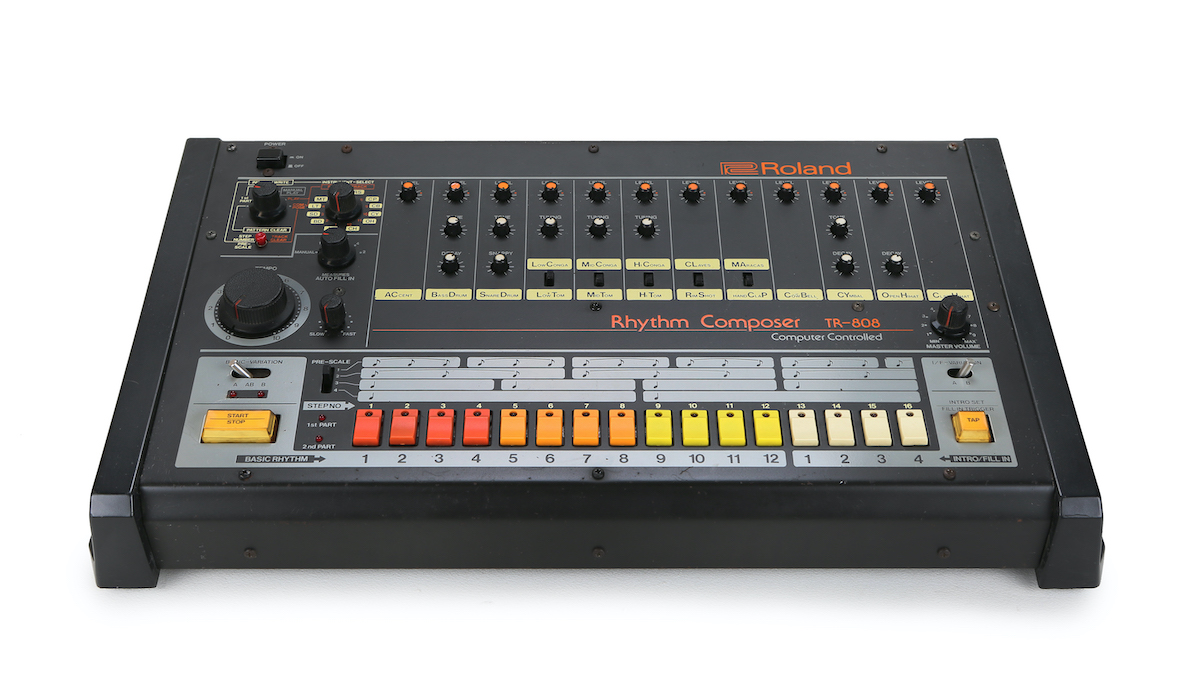
Filter pinging is a great way to synthesize kicks or tom-like sounds. The resonant filter kick drum is most famously employed in the Roland TR-808 kick drum sound. It uses a resonant filter in a twin-T configuration to create its trademark damped sine kick drum. The resonance feedback determines the decay of the kick drum. However, drums are not the only thing that filter pings are capable of creating.
When oscillating, resonant filters produce sine waves, pure tones that can sound a bit dull without processing. Some filters have built-in shaping, such as overdrive, but many do not. Audio-rate frequency modulation is one way to introduce harmonic interest into your filter pinging. Instead of inputting a VCO into a filter's audio input, patch it to the CV input for the filter's cutoff frequency. Filters with attenuators or attenuverters on the CV inputs allow for fine-tuning the amount of modulation and dialing in the sound you want. It creates a more complex sound that may resemble some sounds found with physical modeling synthesis. Turning the frequency of the modulation oscillator down into low or sub-audio rates creates a wobbly squelchy sound as the frequency moves up and down according to the oscillator waveshape.
If the filter you’re using offers voltage-controlled resonance, sending modulation into it allows for animating the dampening of the filter, emphasizing certain pings while reigning in others. Some filters also track at 1V/octave, like a more traditional oscillator. By sending a sequence or keyboard voltage into the frequency input on a filter, you get a plucked melodic synth voice. If you’re using a modulation oscillator with the filter, the pitch sequence can be multed or patched into the CV input on the oscillator to get pitch movement in conjunction with the filter or opposing it.
It's worth noting that while some low pass gates include a ping or strike input...this is not the same thing as filter pinging. Pinging an LPG corresponds to sending a signal into the vactrol controlling the VCA on the low pass gate. This creates a nice organic sound, but the filter isn’t making the sound; it relies on the audio patched into the LPG. Most low pass gates don’t have adjustable resonance, making the filter pinging techniques discussed generally irrelevant...but as with anything else, there are exceptions.

It's also worth noting before we move on that filter pinging has some relevance/conceptual crossover to certain kinds of physical modeling synthesis. Physical modeling is a type of synthesis that seeks to model the behavior of real-world objects and systems. The now-discontinued Mutable Instruments Elements (pictured above) contains a modal resonator comprising 64 zero-delay-feedback state-variable filters to synthesize a wide range of physical objects. By carefully tuning a series of resonant bandpass filters at specific intervals and pinging them, you can synthesize everything from vowel sounds to gongs. This technique even works with analog filters...but for complex sounds, you'll need a lot of them!
Classic Pingable Filters: Hordijk's Twin Peak Resonator
Rob Hordijk’s Twin Peak Resonator is made up of two low-pass filters that share a common resonance control, each running in parallel. The Twin Peak inverts the input signal's phase passing into one of the filters, and the output signal of each filter is summed—so, the resulting output produces only the sounds between the two filters' cutoff frequencies. This is a (rather clever) way of implementing a variable-width bandpass filter—creating a variable bandpass response with two resonance peaks.

[Above: Hordijk's Blippoo Box, containing one of the earliest implementations of his Twin Peak Resonator concept. Image via Ryan Gaston.]
The cutoff frequencies control each filter independently, and the filter frequencies can pass each other in the frequency domain—but unlike the technique of running a highpass filter and lowpass filter in series, they will always output the difference in frequency between the two filters. There are no dead spots, except when both filters are tuned to exactly the same cutoff frequency.
Rob Hordijk's modular systems offered an expanded take on the Twin Peak Resonator concept with multiple audio inputs. With nothing patched into input B, the anti-phase of the signal at input A passes into the second filter. The curve inputs determine how much of each signal passes into the opposing filter. With both curves all the way down in low pass mode, you get two separate low pass outputs mixed together. Increasing the curve moves the output from low pass to band pass filtering by mixing the opposing input into the filter. The Twin Peak filter is especially well suited for filter pinging. It creates everything from glassy to organic, squelchy characteristic pings when the resonance is turned up. This is best heard on the Blippoo Box or as part of a larger Hordijk modular system.
Classic Pingable Filters: Serge VCFQ and Beyond
The Serge VCFQ is one of the most famous filters from the Serge modular synthesis line. Random*Source, in collaboration with Serge Tcherepnin, adapted the iconic design for Eurorack synthesizers, and is included in many of their preconfigured 4U systems.
The VCFQ provides simultaneous lowpass, bandpass, highpass, and notch (band reject) outputs. It has two main audio inputs, In and AGC in, or automatic gain control, which ensures the filter doesn’t distort at high resonance settings. CV inputs include attenuated CV over frequency and resonance and calibrated 1V/oct pitch tracking.
But the thing that interests us in this article is the addition of the ping input. This specialized input is dedicated to pinging the filter, creating a percussive pluck when it receives a trigger. It is separate from the two audio inputs, which can be used in conjunction with the pinging. This leads the VCFQ to act as a primary sound generator in many Serge systems—many "quintessential" Serge patches forego the use of oscillators altogether in favor of a VCFQ running through a waveshaper, wavefolder, or heard all on its own.
The Serge Resonant Equalizer, known as the ResEQ, is a sometimes overlooked part of the Serge modular ecosystem. It’s a 10-band fixed filter bank whose frequency bands correspond to major sevenths (except the top and bottom bands). With the knobs in the center, that band has a flat response. Turning clockwise increases the emphasis at that band with a 12dB/oct curve, while turning counterclockwise subtracts that band from the frequency spectrum at the same curve. This is when the knobs are between 9 and 3 o’clock; going above or below this point adds a resonant peak for additional emphasis or band rejection. The entire system of the ResEQ is connected through a complex network, so each band affects all others with even small changes. It features an input, a mix output of all bands, and two separate outputs that each output half of the bands, with the bands alternating as they go up in frequency.
The Random*Source adaptation of the ResEQ adds a second input, but most importantly for our purposes, a feedback control. This control sends the output back to the input for increased resonance on each of the bands. Sending a trigger signal into one of the inputs allows for a complex ringing sound whose spectra are controlled by each filter frequency band. The interconnected nature of each of the bands comes more clearly into view when used with high feedback and pinging. Each band will uniquely color and shape the full output, making the ResEQ a powerful and deep module.
New Approaches from Make Noise, Joranalogue, and More
The Joranalogue Filter 8 is a unique filter that boasts eight related but separate filter outputs. It oscillates like some of the other filters discussed here, which creates eight phase-shifted sine waves, each 45 degrees out of phase with each other. The outputs include four lowpass with different frequency responses, high pass, band boost/notch, phase shift, and a bandpass output.
The ping input includes a transient generator, so sending your triggers to an external envelope generator is unnecessary. Signals over 3V strike the filter’s core, and each output contains a slightly different response to this behavior. The lowpass outputs provide more kick or tom-like behavior, while the bandpass output is purer and more sine-like, great for pure pings that can be further processed down the signal chain.
The Hikari Ping Filter, as its name suggests, is another filter made with pinging in mind. It features the standard low, band, and high pass outputs plus a white noise output. It also includes a dedicated ping input to excite the filter core.
An internal fuzz circuit adds crunchy distortion to signals passing into the filter and can be used to grit to the pinged sound. While active, the filter resonance doubles as a control of the amount of distortion. This takes the pinging from simple kick and tom sounds to aggressive and distorted thumps. The Ping Filter includes both unattenuated 1V/oct CV over the filter frequency and filter FM with a dedicated attenuverter to control the amount of modulation.
The Make Noise QPAS (Quad Peak Animation System) is a collection of four filters in one module. While it has the traditional controls you may find on many other filters, cutoff frequency and resonance, it also includes radiate controls. The large cutoff knob in the center of the module controls the master cutoff frequency, while the radiate controls spread the four filters apart from this central cutoff point. This allows for four individual filter peaks controlled by the cutoff frequency and radiate controls.
While you can ping the filter by inputting a signal into the audio inputs, Make Noise also includes two inputs marked simply by !!¡¡—which they call the "wildcard inputs"—with little explanation of their function. However, they have some relationship to pinging the filter, as a gate signal creates a small decaying ping with some slight filter frequency modulation. The left wildcard input is subtler, while the right is more aggressive.
The QPAS straddles the line between traditional filters and filter banks. A filter bank is made up of a series of filters, almost always bandpass filters. While they usually are fixed, meaning you cannot adjust their frequencies, a few filter banks allow you to adjust the different frequency bands. The intervals of the filter bands sometimes correspond to musical intervals, such as 5ths, 7ths, or octaves, but not always. Instead of frequency control, you get to control the amplitude of each band of the filter, adding or subtracting that frequency band to the output. The QPAS does not have individual level controls but allows for full control over the cutoff frequencies. Due to the fact that the QPAS has four filters, you can adjust the filter frequencies to play chords or, if you’re using the bandpass outputs, create formant vowel-like sounds.
Rings, Pings, and All of Those Things
Pinging filters unlocks a new way to synthesize sounds using modules you may already have in your setup. Experiment with filter types, trigger sources, and different kinds of modulation and see where it takes you. Whether you want another way to generate thumping kick drums or want to create complex sounds reminiscent of physical modeling, filter pinging is a great way to get these sounds and many more.


